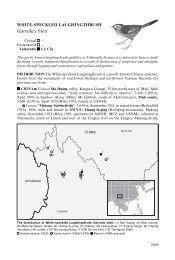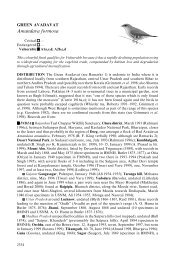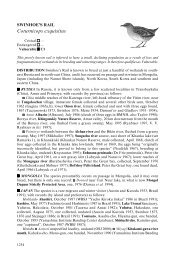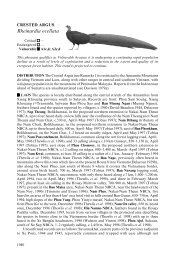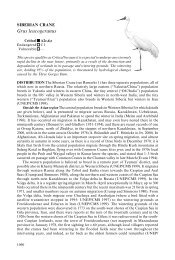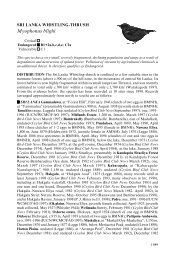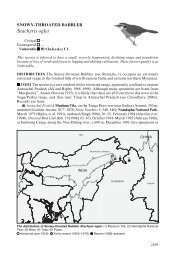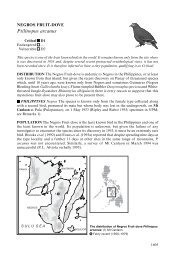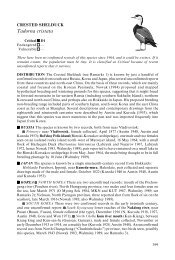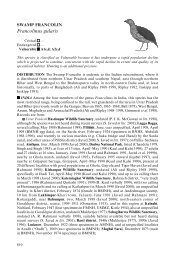Carpococcyx viridis - BirdBase
Carpococcyx viridis - BirdBase
Carpococcyx viridis - BirdBase
You also want an ePaper? Increase the reach of your titles
YUMPU automatically turns print PDFs into web optimized ePapers that Google loves.
SUMATRAN GROUND-CUCKOO<br />
<strong>Carpococcyx</strong> <strong>viridis</strong><br />
Critical D1<br />
Endangered —<br />
Vulnerable —<br />
This terrestrial forest bird has not been recorded for almost a century, nor apparently is it familiar<br />
to experienced hunters in Sumatra. Its population is thus quite possibly tiny, and as such it<br />
qualifies as Critical.<br />
DISTRIBUTION The Sumatran Ground-cuckoo (see Remarks 1) is confined to the island<br />
of Sumatra, Indonesia, where all records have come from the Southern Barisan Mountains<br />
in the southern half of the island. Records, given in full in Collar and Long (1995) but repeated<br />
with original sources here, are based on eight museum specimens (see Remarks 2), three of<br />
which simply specify “Sumatra” and five of which indicate:<br />
■ INDONESIA Sumatra ■ Bengkulu Gunung Singgalang (the type locality) at Bella Vista,<br />
July 1878 (Salvadori 1879; “juvenile” in MSNG); ■ West Sumatra Padang Highlands, 1880<br />
(juvenile in RMNH); Muara Sako, Indrapura (by Gunung Kerinci; see Remarks 3), 300 m,<br />
September 1915 (Robinson and Kloss 1924a; immature female in RMNH); Rimbopengadang,<br />
Lebong, 1,000 m, June 1916 (Robinson and Kloss 1924a; male in ZRCNUS); ■ South Sumatra<br />
MALAYSIA<br />
S O U T H<br />
C H I N A<br />
S E A<br />
SIMEULUE<br />
ISLAND<br />
NIAS<br />
ISLAND<br />
I N D I A N<br />
O C E A N<br />
SIBERUT<br />
ISLAND<br />
1<br />
2<br />
3<br />
BANGKA<br />
ISLAND<br />
4<br />
5<br />
SUMATRA<br />
ENGGANO<br />
ISLAND<br />
The distribution of Sumatran Ground-cuckoo <strong>Carpococcyx</strong> <strong>viridis</strong>: (1) Gunung Singgalang; (2) Padang<br />
Highlands; (3) Muara Sako; (4) Rimbopengadang; (5) Gunung Dempo.<br />
Historical (pre-1950)<br />
1715
Threatened birds of Asia<br />
Gunung Dempo at the Air Njuruk (“an insignificant brook”: Robinson and Kloss 1924a),<br />
(Pasemah), Palembang, 1,400 m, August 1916 (Robinson and Kloss 1924a; male in RMNH).<br />
In July 1999 a local guide reported seeing the species in forest above Tapan within Kerinci-<br />
Seblat National Park (D. Martyr per K. D. Bishop in litt. 1999).<br />
POPULATION Nothing is known about the population status of this species. The fact that<br />
it has not been seen since 1916 is a clear cause of concern; on the other hand, Sumatra has<br />
endured considerable ornithological neglect throughout this century, and a close relative on<br />
Borneo, the Bornean Ground-cuckoo <strong>Carpococcyx</strong> radiatus, has proved to be a highly<br />
unobtrusive species (Collar and Long 1995), so it may reasonably be hoped that intensified<br />
fieldwork within the range defined under Distribution will duly relocate populations of the<br />
Sumatran Ground-cuckoo at a number of sites. It has been reported that none of the local<br />
hunters and trappers at Kerinci who recognise pictures of the area’s rare pittas has recognised<br />
the proferred picture of this species (Holden 1997); however, in 1999 at least one old poacher<br />
instantly recognised an illustration and reported seeing the species occasionally during<br />
poaching forays (F. Verbelen in litt. 1999).<br />
ECOLOGY Habitat This species evidently occupies foothill and montane forest, with records<br />
from 300 to 1,400 m (see Distribution); it was described as a bird of hill country by its<br />
discoverer (Beccari 1878). Other comments made about the species in the wild are that it lives<br />
“on the ground in gallinaceous manner” (Salvadori 1879, Collar and Long 1995) in “the<br />
heavy forest” (Robinson and Kloss 1924a); the type and at least two other specimens were<br />
caught in snares (Salvadori 1879, Robinson and Kloss 1924a). Forest at the collecting locality<br />
on Gunung Dempo “was composed of very tall trees, and the undergrowth was easy to cut<br />
through”; forest at Muara Sako covered the “surrounding heights”, and Great Arguses<br />
Argusianus argus were numerous; and forest at Rimbo Pengadang was secondary near the<br />
road but heavy further inland, although there is no indication where the relevant specimen<br />
came from (Robinson and Kloss 1924a). There is always a possibility that the records from<br />
the hills and mountains mask the fact that the species also occurs in the lowlands, since this<br />
is the case with the Bornean Ground-cuckoo (Collar and Long 1995); and the record from<br />
Muara Sako (see Remarks 3) hints further at this. However, a poacher who recognised the<br />
species indicated that he had found it in what was interpreted to mean dark, closed-canopy<br />
areas of pristine submontane forest (F. Verbelen in litt. 1999).<br />
Food Presumably the species eats small vertebrates and large invertebrates that dwell on<br />
the forest floor. The Kerinci immature had insects in its stomach (RMNH label data) and the<br />
species was characterised as feeding on insects (Robinson and Kloss 1924a).<br />
Breeding A possible juvenile taken in July, and an immature taken in September, indicate<br />
breeding in the first half of the year.<br />
THREATS Deforestation on Sumatra has been extensive, lowland areas suffering most acutely<br />
(see Threats under Rueck’s Blue-flycatcher Cyornis ruecki); however, many foothill and<br />
montane areas have also been affected, with at least a third of montane forest having been<br />
lost, and clearance continues to extend well through the existing elevational range of many<br />
species endemic to the uplands of Sumatra (“Sumatra and Peninsular Malaysia Endemic<br />
Bird Area”: see Sujatnika et al. 1995, Stattersfield et al. 1998), and is here judged to be a<br />
threat to this species and also Salvadori’s Pheasant Lophura inornata, Aceh Pheasant L.<br />
hoogerwerfi, Schneider’s Pitta Pitta schneideri, Graceful Pitta Pitta venusta and Sumatran<br />
Cochoa Cochoa beccarii. Already in 1913–1917 Gunung Singgalang, where the Sumatran<br />
Ground-cuckoo was first collected, had been cleared up to 1,800–1,900 m, and even above<br />
this the mountain forest had been selectively logged; conditions on the north and east slopes<br />
were particularly bad, although the south and west were still forested (Robinson and Kloss<br />
1716
<strong>Carpococcyx</strong> <strong>viridis</strong><br />
1924a). Forest at “Air Njuruk” on Gunung Dempo appears all to have been cleared, and<br />
there may be little or no forest left on the mountain within the ground-cuckoo’s known<br />
altitudinal range (F. Verbelen in litt. 1999). In the great fires on Sumatra in 1997 Bukit Barisan<br />
Selatan National Park was affected at least marginally (Kinnaird and O’Brien 1998).<br />
In 1984 Kerinci-Seblat National Park was cited as one of the 10 most threatened protected<br />
areas in the Indo-Malayan Realm, owing to illegal encroachment of farming (Thorsell 1985);<br />
in 1988 habitat below 1,900 m on Gunung Kerinci itself was disturbed, and below 1,800 m it<br />
did not exist, as a result of the “constant assault” of clearing and burning (Hurrell 1989).<br />
Nothing has changed except for the worse. Conservation initiatives in Kerinci are hampered<br />
by the logistical difficulties associated with managing a reserve of this size, compounded by<br />
the crisis of legitimacy facing the state forest regime since the fall of President Suharto’s New<br />
Order government: in the power vacuum and great political and social uncertainty that<br />
currently characterise Indonesia, networks of local exploitation interests are appropriating<br />
land and timber resources within the park, and the government currently lacks the capacity<br />
to enforce law and order in this area (P. Jepson in litt. 2000; see also Remarks 4). In September<br />
1999, the area of the Padang Highlands between Padang and Bukittingi was explored by<br />
road, and the entire area of Kerinci-Seblat National Park from Padang southwards was flown<br />
over: the conclusion was that “extensive clearance and degradation is continuing to affect all<br />
forests in the highlands, with intrusions into the park along its entire boundary wherever<br />
valleys and watercourses present access opportunities, and the entire park is subject to<br />
seemingly unrestricted logging, mainly at lower elevations, clearance for plantations and<br />
squatter settlements, poaching and illicit collection of forest products” (K. D. Bishop in litt.<br />
2000). Another visitor to Kerinci-Seblat National Park also found that deforestation is taking<br />
place within its boundaries, involving agricultural encroachment by local communities and<br />
commercial logging by both semi-industrial interests (at Muara Sako) and individuals with<br />
chainsaws on an everyday basis (F. Verbelen in litt. 1999). Preliminary analysis of satellite<br />
imagery suggests that, while there are still some intact, inaccessible areas in the core of the<br />
park, there are new roads into the park from adjacent logging concession areas, and that the<br />
practice of stripping timber out of the park by commercial interests is on a much larger and<br />
more systematic scale than has hitherto been realised; the northern part of the Kerinci valley<br />
forest is being lost at a rate of 3% a year owing to encroachment of various kinds (F. R.<br />
Lambert in litt. 2000).<br />
Hunting with air rifles is widespread in the lower forest at Kerinci, which may be a threat<br />
to the species (F. Verbelen in litt. 1999). Moreover, ground snares are widespread and likely to<br />
be a particular problem for it (K. D. Bishop in litt. 2000).<br />
MEASURES TAKEN Protected areas Altogether there are 20 protected areas in the Barisan<br />
Range (Stattersfield et al. 1998), although some of these lie to the north of the known range<br />
of this ground-cuckoo. Gunung Singgalang is a 97 km 2 protection forest, but with garden<br />
(“ladang”) encroachment along the lower peripheries (SvB). Bukit Dingin/Gunung Dempo<br />
consists of c.380 km 2 of protection forest (SvB). One site (Muara Sako; see Distribution) at<br />
which the species has been recorded is inside or very close to a protected area, namely Kerinci-<br />
Seblat National Park, although it is not clear whether the record came from within the<br />
subsequent park boundaries or not, and in any case Kerinci continues to be modified by<br />
deforestation (see Threats).<br />
In 1997 the government commenced the Kerinci-Seblat Integrated Conservation and<br />
Development Project (due to last until September 2002) funded by a major grant from the<br />
Global Environment Facility, aimed at tackling the threats facing the park through four<br />
integrated components: (1) park management, which focuses on planning, enforcement and<br />
interpretation; (2) village-area development, which aims to reduce the impact of communities<br />
living around and within the park; (3) biodiversity in concession management, which is<br />
1717
Threatened birds of Asia<br />
developing wildlife-sensitive management of neighbouring logging concessions; and<br />
(4) monitoring and evaluation, which tracks changes in the status of forest and key indicator<br />
species (P. Jepson in litt. 2000; see also MacKinnon 1997). In addition to these activities, the<br />
Fauna & Flora International Orang Pendek project has surveyed certain areas of the park<br />
and extending knowledge on the distribution and status of several threatened birds species<br />
(e.g. Holden 1997).<br />
The admirable efforts of F. Verbelen in searching for this species, and in interviewing over<br />
50 hunters and poachers, demonstrate the key role individual birdwatchers can play in assisting<br />
the cause of species conservation.<br />
MEASURES PROPOSED This is a BirdLife restricted-range species confined to the Sumatra<br />
and Peninsular Malaysia Endemic Bird Area (Stattersfield et al. 1998; also Sujatnika et al.<br />
1995). Surveys of known sites and in good forest at 300–1,400 m between sites are urgently<br />
required in order to rediscover this species and assess its conservation status and needs; such<br />
fieldwork should extend to the northern regions of western Sumatra, perhaps into the Barumun<br />
reserve of South Tapanuli, to ascertain the northern limits of this and other Sumatran endemic<br />
hill species (D. A. Holmes in litt. 1999). Two sites recalled by the poacher interviewed by F.<br />
Verbelen (in litt. 1999) are Gunung Rajah above Desa Lempur, and Lubuk Pinang, 40 km<br />
from Tanjung Pondok. A major effort is needed in Sumatra to identify and protect the lowestlying<br />
remaining areas of hill forest, which may prove to be crucial to this species, given that<br />
the lowest elevation recorded for it was only 300 m (see Ecology). Both Gunung Singgalang<br />
and Bukit Dingin/Gunung Dempo are proposed for upgrading to reserves (D. A. Holmes in<br />
litt. 1999). A strict hunting ban is needed at Kerinci and Dempo (F. Verbelen in litt. 1999).<br />
REMARKS (1) The recognition that the Sumatran Ground-cuckoo is a distinct species from<br />
Bornean <strong>Carpococcyx</strong> radiatus only occurred recently (Collar and Long 1995; hence Inskipp<br />
et al. 1996, del Hoyo et al. 1997), although an earlier but neglected assertion of its identity<br />
had been made almost a century earlier by Finsch (1898). (2) A ninth (mounted and seemingly<br />
nineteenth-century) adult specimen, unfortunately lacking data, was found during a visit to<br />
SMNS in 1997 (NJC). (3) This locality was identified by E. Jacobson as at “West Coast<br />
Sumatra”, but this was an old Dutch province name and referred to western Sumatra, not to<br />
the coastal region (D. A. Holmes in litt. 1999), and indeed Jacobson qualified this the site as<br />
being along a path up a valley towards Kerinci (in Robinson and Kloss 1924a); the mapping<br />
of the site as at Kerinci itself (in Collar and Long 1995) missed this information. (4) The<br />
following further information on problems at Kerinci-Seblat is all from P. Jepson (in litt.<br />
2000). There is widespread encroachment, exploitation and poaching within the park’s<br />
designated boundaries. The structure, pattern and conservation impact of these activities is<br />
complex and varies depending on local characteristics of landscape, culture, and economics.<br />
For example, the lowland forest landscapes on the south-western faces of the Barisan ranges<br />
are being degraded by the confusion of boundaries with commercial logging concessions<br />
and small-scale timber extraction to feed local saw-mills located just outside the park<br />
boundaries. The middle hills of the park provide the ideal setting for growing cinnamon,<br />
while conversion of forest lands along the roads through the park is widespread and linked<br />
into influential trade chains orientated around the cities of Padang, Jambi and Bengkulu.<br />
This pressure is causing major fragmentation of the area: for example, the species-rich Gunung<br />
Tujuh massive is now isolated from the rest of the park by cinnamon plantations. Some<br />
threats are more specific in their location. A good example is the vegetable-growing business<br />
that seeks out the exceptionally fertile soils associated with volcanic lahars. Such landforms<br />
and soils are rare, but unfortunately the lower slopes of Kerinci are one such an area; as a<br />
result, there is rapid encroachment as forests are felled to grow cabbages.<br />
1718



